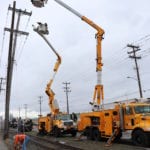
Updated April 24
On Friday, April 5 around 3:50 p.m., 26 utility poles came down along East Marginal Way South in Tukwila. We will provide updates in this space as they become available. Here is what we know now:
Immediate Response
At the outset of the event, seven City Light crews with about 40 workers responded to the scene. Our first priority was the safety of two people in the vehicle hit by a pole and our first responders. Next was restoring power to our approximately 16,500 impacted customers. Our crews got all but around 300 customers back on by about 6 p.m. Friday. They kept working through the night and by Saturday morning, only 13 customers remained out. We continue to be in contact with those customers as we work to restore their service (more on that below).
We also focused on clearing the road of debris. Once we completed that work late Saturday morning, we turned it over to the City of Tukwila to address their impacted streetlights. The road was reopened by the afternoon.
Finally, City Light engineers were also onsite over the weekend, assessing the situation to determine and begin designing necessary permanent fixes.
Under our wood pole inspection/replacement program, we have replaced approximately 15,000 wood poles across City Light’s service area since 2010 (see this 2017 Seattle Channel video about the pole inspection process). The poles along this road were inspected in 2016 by a third-party vendor as part of that process. At that time, we treated a number of poles in accordance with normal industry standard and identified several for replacement over the coming years. None were identified as priority one (in need of immediate replacement) or posing a public safety hazard. (see more information about the poles and inspection process added below).
To ensure full accountability and impartiality, we will contract with a third party to assist in a thorough investigation. We hope to have the contract initiated today. The process will include reviewing previous inspection records, inspecting the damaged poles and equipment, which have been collected and transported to a City Light facility, as well as obtaining and reviewing any available video from the vicinity. At this time, we do not have an estimate for how long this investigation will take to complete.
April 11 update: Despite ongoing efforts that began within a few days of the incident, initiating the third-party investigation has been a slower process than we’d hoped. As we developed the scope of work and level of public scrutiny that this engagement would require, we realized that it was important to find a firm with the specific skills, capacity and interest to conduct a robust investigation in a timely manner. We’ve had conversations with several firms and we’re now in discussion with a national engineering firm and plan to engage an appropriate firm as soon as possible.
The good news is that we’ve secured the poles and infrastructure that came down last Friday, which means the investigation itself will not be compromised by the delayed start. One of the focus areas for the investigation will be whether we are replacing identified poles at an appropriate pace.
April 16 update: The Seattle City Attorney’s Office (CAO) is coordinating the City’s investigation into the 26 power poles that came down on April 5. The CAO retained a key investigator on April 15, and will add experts to the team in the coming weeks. At this time, although we would like for the investigation to proceed as quickly as possible, we are unable to predict how long it will take.
April 24 update: The City was recently provided video that shows some of the poles falling. Given that this is the first video showing these particular poles that the City is aware of, Seattle City Light is posting the video here. The video starts as rain and wind begin in the area and appears to abruptly stop when the camera loses power.

The downed poles were moved to a secure yard and covered to protect from the elements. They will be inspected by a third-party firm as part of the investigation.
City Light is prioritizing work to assess, design and construct permanent fixes to the system in this location. Today, we are preparing for construction of the circuits, so that work can begin once engineering completes the design. Crews will be working 12 hours, seven days a week to get power restored to this area. Once work is underway, we estimate that the full restoration process will take approximately two to three weeks to complete.
April 24 update: On Friday, April 19, two weeks after 26 utility poles came down along East Marginal Way South, City Light crews energized the last two customers who had been without power since the initial incident. While there is work still to be done, this restoration was accomplished more quickly than initially anticipated. Thanks goes to our hard-working, dedicated crews who enjoyed a much needed weekend off after working 12 hours a day, seven days a week. In the coming days we’ll be cleaning up the construction staging area, making sidewalk repairs and restoring vegetation where necessary, as well as working to cut over two customers, the Museum of Flight and the Raisbeck Aviation High School, from temporary to permanent power.
City Light is working with the seven unique customers (13 meters) that are impacted by the continued outage and planned restoration work along East Marginal Way South. We are currently working with individual customers to determine and meet their specific energy needs.
April 10 update: Our engineers have identified and are implementing temporary measures to restore power to some of the customers that remain without. This afternoon, we turned on temporary power to the Museum of Flight (those buildings not yet restored). Barring any unforeseen circumstances, we are confident we can provide temporary power to the Raisbeck Aviation High School, which is on spring break, sometime tomorrow. The full permanent restoration is still expected to take two to three weeks to complete.
April 11 update: This afternoon, we turned on temporary power to the Raisbeck Aviation High School.
April 24 update: On of Friday, April 19, City Light crews energized the last two customers who had been without power since the initial incident.
Additional information added April 11:
The 26 poles that fell on East Marginal Way South range significantly in age; the oldest two were installed in 1954 and the five newest in 2011. All were inspected in December 2016.
As part of the pole inspection process (described below), poles are assigned a priority rating from 1 to 5; poles identified as P1 or P2 are flagged for replacement, although P2 poles do not require immediate replacement and maintenance is suggested within a “practical timeframe.” The poles that fell on East Marginal Way South had priority ratings between P2 and P5 and the eight P2 poles were included in City Light’s Capital Improvement Plan.
Poles “age” at different rates for a variety of reasons, including location, soil characteristics, wood density, physical environment and treatment applied. It’s a complex process that the industry has studied for many years. As poles age, water is absorbed and over time, the resulting bacteria attacks the integrity of the wood. Hence the investment in aggressive “test and treat” programs by all electric utilities. As an example, in the 2016 inspection cycle one of the 1954 poles was assigned a P2 rating and the other was assigned a P4 rating.
City Light’s “Inspection Procedures for Wood Pole Assessment” were developed in conjunction with a third-party vendor and are carried out by a second third-party vendor. As designed, the program evaluates the integrity of the overhead line system by using skilled workers equipped with appropriate tools to aid their judgement. Each of City Light’s 93,000 individually or jointly owned poles that have been in service for five years or more are to be inspected on a 10-year cycle. The 26 poles that fell were a mixture of individually owned and jointly owned poles with both City Light and communication entities’ equipment attached. The inspection process includes a visual, sound and bore partial excavation inspection as demonstrated in this 2017 Seattle Channel video and described in this 2014 blog post.
City Light’s wood pole inspection program was put in place in 2011, which makes it a relatively new area of focus, but one where we are making steady improvement. If the third-party investigation or our own internal review reveals changes to our current pole inspection program are advisable, we will pursue those adjustments in the near term.


